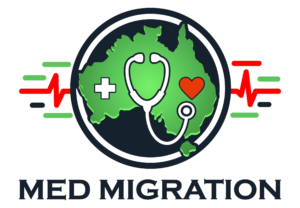Australia offers exciting and rewarding career opportunities for qualified midwives — both those trained locally and internationally. With consistent national demand for midwifery services, especially in regional and rural areas, there are strong pathways for registration, visa sponsorship, and permanent residency (PR) for those seeking to build a life and career in Australia.
In this article, we’ll cover:
- How to get registered as a midwife in Australia
- Visa sponsorship and PR pathways
- Where the highest demand for midwives is
- How MedMigration can help you every step of the way
1. Why Midwifery Is in High Demand in Australia
✅ Australia’s population growth, combined with regional workforce shortages, means midwives are consistently listed on the Medium and Long-Term Strategic Skills List (MLTSSL).
✅ Government investment in maternity services, women’s health, and rural healthcare is driving even greater demand.
✅ Many hospitals, health services, and birthing centres are actively offering employer sponsorship for qualified midwives.
📌 According to Health Workforce Australia, midwifery shortages are projected to continue well into 2030, especially in rural and regional areas.
2. How to Get Registered as a Midwife in Australia
Before you can practice as a midwife in Australia, you must obtain registration with the Australian Health Practitioner Regulation Agency (AHPRA).
📋 Registration Steps for Internationally Qualified Midwives:
🔹 Primary Source Verification through EPIC (Educational Commission for Foreign Medical Graduates) — confirming your qualifications.
🔹 Skills Assessment – International midwives must be assessed against the standards set by the Nursing and Midwifery Board of Australia (NMBA).
🔹 English Language Requirements – Meet IELTS or OET scores (e.g., IELTS 7.0 across all bands or OET B level).
🔹 Bridging Program (if needed) – Some internationally qualified midwives may need to complete a Midwifery Outcome-Based Assessment (OBA) or a bridging course.
📌 More information on registration: AHPRA Registration for Midwives
3. Visa Sponsorship and Permanent Residency (PR) Pathways for Midwives
Since midwifery is on the MLTSSL, there are several visa options for those seeking sponsorship and PR:
✅ Subclass 482 – Temporary Skill Shortage (TSS) Visa
- Employer-sponsored visa for up to 4 years.
- Midwives can transition to PR after 2–3 years through Subclass 186.
✅ Subclass 186 – Employer Nomination Scheme (Direct Entry PR)
- Direct permanent residency if sponsored by an approved employer.
- Best for experienced midwives.
✅ Subclass 189 – Skilled Independent Visa (Points Tested PR)
- No sponsorship required; based on points (skills, age, English, experience).
- Must have a positive skills assessment.
✅ Subclass 190 – Skilled Nominated Visa (State Sponsored PR)
- Requires nomination from an Australian state or territory.
- 5 bonus points for state nomination.
✅ Subclass 491 – Skilled Work Regional (Provisional) Visa
- Work in regional Australia for 3 years, then become eligible for PR through Subclass 191.
- Many regional hospitals and birthing centers offer strong incentives for midwives.
📌 Tip: Working in a regional area can often speed up your PR journey and offer relocation benefits!
4. Where Are Midwives Most Needed in Australia?
Midwifery shortages exist nationwide, but demand is especially high in regional and rural areas:
📍 High-Demand Locations for Midwives:
- Regional Victoria: Geelong, Ballarat, Shepparton
- New South Wales: Wagga Wagga, Dubbo, Tamworth
- Queensland: Cairns, Rockhampton, Mackay
- Western Australia: Geraldton, Bunbury, Kalgoorlie
- South Australia and Tasmania: Mount Gambier, Launceston, Devonport
📌 Job portals like RWAV (Victoria), Health Workforce Queensland, and NSW Rural Doctors Network regularly list midwifery roles offering visa sponsorship.
5. Why Work as a Midwife in Regional Australia?
✔ Visa Priority – Regional sponsored roles often receive priority visa processing.
✔ Financial Incentives – Many employers offer relocation assistance, rural loading bonuses, and rental subsidies.
✔ Career Growth – Midwives in rural areas often enjoy broader clinical responsibilities and faster promotions.
✔ Work-Life Balance – Enjoy a relaxed lifestyle, lower cost of living, and strong community connections.
6. How MedMigration Can Support You
At MedMigration, we specialise in helping midwives migrate successfully to Australia.
We offer support in:
✔ Registration Guidance: Helping you navigate the AHPRA registration process.
✔ Skills Assessment: Assistance with NMBA and skills verification.
✔ Job Placement: Connecting you with hospitals and birthing centres offering sponsorship.
✔ Visa Support: Managing your Subclass 482, 186, 189, 190, or 491 visa application.
✔ Regional Opportunities: Access to employer networks in regional Australia for faster PR.
Final Thoughts: Build Your Future as a Midwife in Australia
If you are a passionate and qualified midwife, Australia offers unmatched career opportunities, visa sponsorship, and a pathway to permanent residency. With MedMigration by your side, your dream of working and living in Australia is closer than ever.
🚀 Ready to Start Your Midwifery Journey in Australia?
✅ Get personalised migration support at MedMigration
✅ Check visa options at Home Affairs – Skilled Migration
📌 Your skills are in demand. Start your journey today!


One response
I like the efforts you have put in this, regards for all the great content.